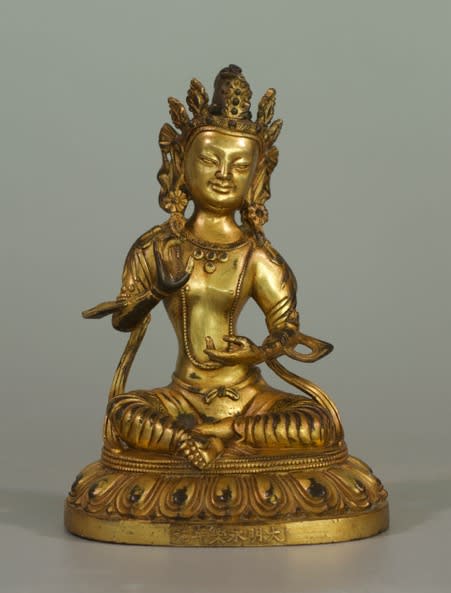Gilt-Bronze Figure of Green Tara, 1402 CE - 1424 CE
Gilt-Bronze
7.9
CB.2890
This is a gilt-bronze sculpture of Green Tara. Dressed in bodhisattva outlook, she is wearing a crown and flower earrings. Her keyura and clothing are simplistic yet elegant, with extra...
This is a gilt-bronze sculpture of Green Tara. Dressed in bodhisattva outlook, she is wearing a crown and flower earrings. Her keyura and clothing are simplistic yet elegant, with extra attention paid to the details of her lower body dress. Her right hand is in dharmacakra mudra in front of her chest, while her left hand in dhyana mudra in front of her waist. She is seated in a relaxed posture, extending her right leg slightly in front. The inscription "Made in Yongle era in Ming dynasty" suggests its Chinese origin and the style it adopts, if not the period it was actually made. This evidence is echoed by the stylistic features shown, such as the three rows of encircling beads above the lotus petals. It is noteworthy that the form of the sculpture is slightly unconventional, since her hand gestures are mirrored compared to the conventional form.
Tara is a completely enlightened buddha and having promised to appear in the form of a female bodhisattva and goddess for the benefit of all beings she especially protects from the eight fears. As a merciful protector of all people, Tara is second in popularity only to Avalokiteshvara. Among the many manifestations of Tara, white and green are the most commonly depicted forms. Among them, Green Tara is primarily associated with protection. She is revered and worshipped as she guards sentient beings from unfortunate events and evil deeds. This elegant figure of Green Tara, forming a fear-not mudra, grants her followers a sense of security and reliance, embracing them with her feminine power.
Danny Ching
Tara is a completely enlightened buddha and having promised to appear in the form of a female bodhisattva and goddess for the benefit of all beings she especially protects from the eight fears. As a merciful protector of all people, Tara is second in popularity only to Avalokiteshvara. Among the many manifestations of Tara, white and green are the most commonly depicted forms. Among them, Green Tara is primarily associated with protection. She is revered and worshipped as she guards sentient beings from unfortunate events and evil deeds. This elegant figure of Green Tara, forming a fear-not mudra, grants her followers a sense of security and reliance, embracing them with her feminine power.
Danny Ching
